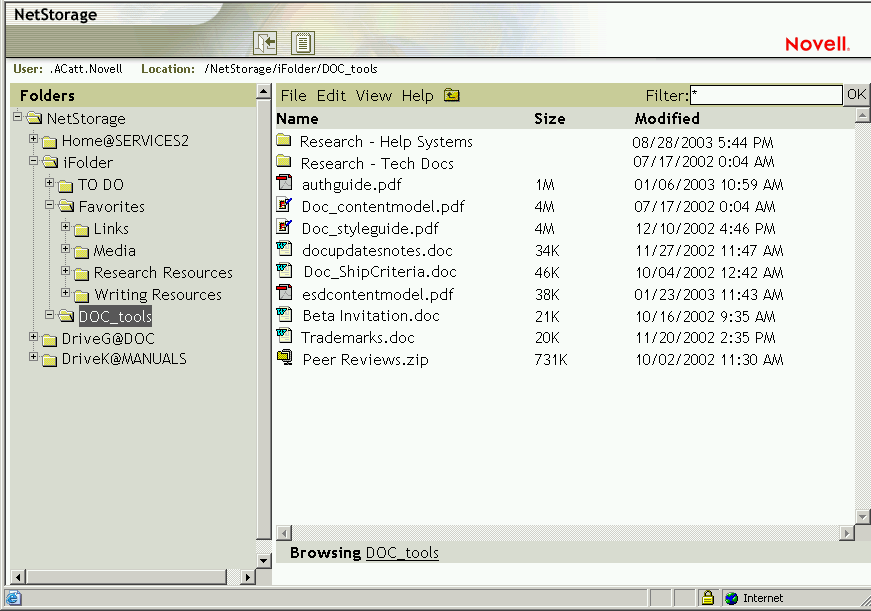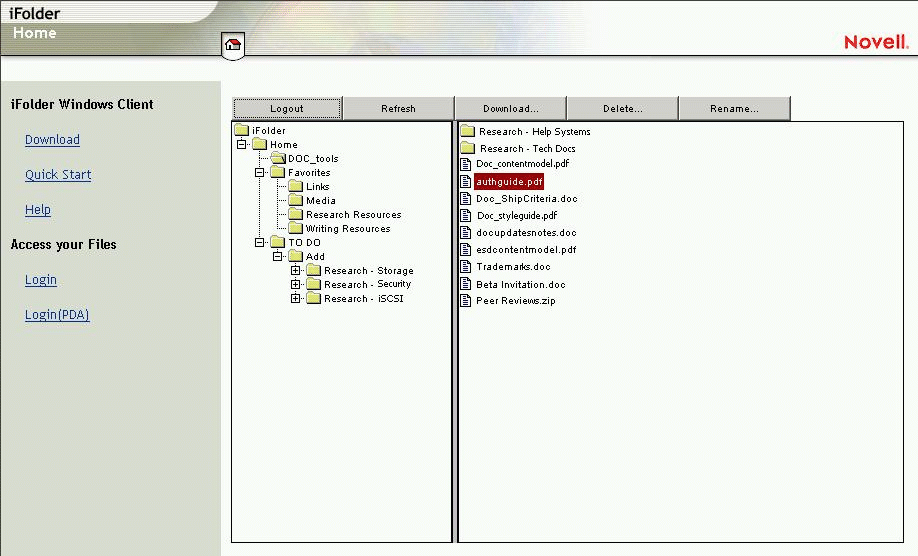3.1 Accessing iFolder Files Using a Web Browser
With Novell iFolder, you can access your iFolder data from any computer that has an active Internet or network connection—even from your handheld devices. From a Web browser, you can view, access, and modify all of your iFolder files stored on the iFolder server.
When you access your iFolder files through a Web browser, you can download only the files that you need instead of the whole directory. However, there is no automatic synchronization of changes to the iFolder server, as with the iFolder client.
When you use a browser, you must manually download and save files to your desktop, work on them, and then upload the files to the Folder server. After the files have been uploaded to the iFolder server, iFolder synchronizes the changes to your other computers that do use the iFolder client.
If you are working on a computer that is not yours, delete the files that you worked on from the location where you saved them on the hard drive; otherwise, someone could access them after you are gone.
With iFolder, you can access your account using any of the following Web access methods that are supported in your network environment:
-
Java Applet (iFolder Web Site View): Go to the following URL, then click Login to open the Java applet.
http://nif1.your-domain-name.com/iFolder
-
Java Applet (Applet Only View): Go to the following URL to open the Java applet.
http://nif1.your-domain-name.com/iFolder/applet/java.htm
-
NetStorage (Folder View): Go to the following URL, then log in to access your iFolder files. The folder view uses frames on the Web page to display the file management options.
http://nif1.your-domain-name.com/NetStorage
-
NetStorage (Text View): Go to the following URL, then log in to access your iFolder files in a text view. The text view does not use frames to display file management options. It is an HTML-only view that is compatible with most Web browsers used on handheld devices.
http://nif1.your-domain-name.com/oneNet/NetStorage
-
Virtual Office: Go to the following URL, then log in to access your iFolder files.
http://nif1.your-domain-name.com/vo
In each example URL, replace nif1.your-domain-name.com with the actual IP address or DNS name of your iFolder server. Get this information from your iFolder administrator.
For more information about the two main Web-based interfaces:
3.1.1 Accessing Files Using Novell NetStorage
If Novell NetStorage services are available on your system, your administrator can configure NetStorage to support iFolder data access. Novell NetStorage is available in the bundled release of iFolder 2.1.x with NetWare® 6.5 and later and with Novell Nterprise™ Linux Services.
To access your iFolder data using the NetStorage folder view, enter the following URL in your Web browser:
https://nif1.your-domain-name.com/NetStorage
Figure 3-1 Example of the Novell NetStorage Folder View

To access your iFolder data using the NetStorage text view, enter the following URL in your Web browser:
https://nif1.your-domain-name.com/oneNet/NetStorage
IMPORTANT:The NetStorage folder view and text view URLs are case sensitive.
Figure 3-2 Example of the Novell NetStorage Text View

3.1.2 Accessing Files Using the iFolder Java Applet
The iFolder Java applet provides basic file access to your iFolder data. You can browse, upload, download, copy, move, delete, and rename files.
-
Activate your Internet or network connection.
-
Go to the iFolder Web site using one of these methods.
- Right-click the iFolder icon in the system tray, then click iFolder Web Site.
- Open your Web browser directly to the iFolder Web
site. For example, enter
http://nif1.your-domain-name.com/iFolderReplace nif1.your-domain-name.com with the actual DNS name or IP address of your iFolder server. You can get this information from your iFolder administrator.
-
Do one of the following:
- Click Login to access your local iFolder
directory using the iFolder Java* applet.
In order to view and manipulate your iFolder files using the Java applet, you must install and enable Sun Java Virtual Machine 1.3 or later on your computer. To download free Java software, see the Java Web site.
- For iFolder 2.1 and 2.1.1, click Login (PDA) to
access your local iFolder directory via HTML access (for PDA devices
such as Palm* Pilots, etc.).
This option is not available in iFolder 2.1.2. Instead, use the Novell NetStorage text view.
- Click Login to access your local iFolder
directory using the iFolder Java* applet.
-
Enter your user ID, password, and encryption passphrase (if required), then click Connect.
The IP address of your iFolder server should already be filled in for you.
After you are logged in, the iFolder Java applet displays the network files and folders currently accessible to you. They appear in a directory structure similar to what you would see in Windows Explorer.
Figure 3-3 Example of the Java Applet via the iFolder Web Site

Click Folder View to display folders in another column and to expand and collapse folders. The Text View only displays the files and folders in the current directory and does not allow you to expand or collapse folders.
You can use many of the same conventions for expanding and collapsing folders and opening files that are available in Windows Explorer. To expand the folder and view the files, double-click the Home folder. To create new folders or copy, delete, rename, move, upload, or download existing files or folders, click the down-arrow next to the file or folder.
IMPORTANT:When downloading or uploading iFolder files from a browser, do not click any of the links on the current page; otherwise, the file transfer will be interrupted. If you want to go to another Web site while downloading or uploading files, open another browser window.
Local files and folders are not accessible using this interface. Use the file directory interface on your workstation to view local files and folders.